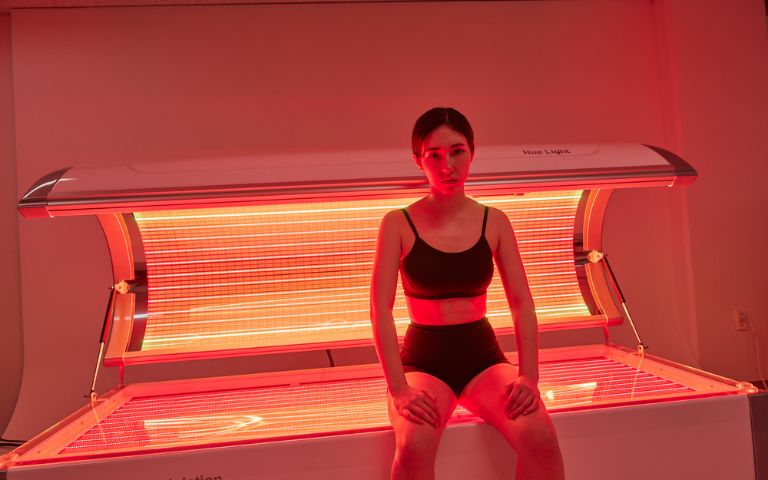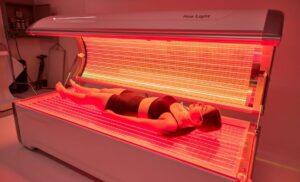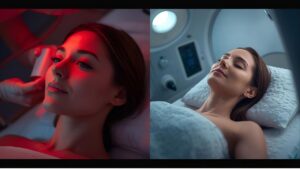In recent years, light therapy treatments such as low-level light therapy (LLLT), LED therapy and phototherapy have gained widespread attention for their potential to improve skin health, cellular repair, collagen production, pain management, muscle recovery, wound healing, and even brain function. Among these, two terms frequently come up: Low-Level Light Therapy (LLLT), commonly referred to as Red Light Therapy (RLT or PBM therapy), and Photobiomodulation (PBM).
At first glance, they seem interchangeable. Both use specific wavelengths of light in the red or near-infrared (NIR) spectrum. But in reality, they differ in precision, purpose, and application, making it essential to understand their roles in clinical applications, wellness routines, and medical research.
Understanding the differences between photobiomodulation and red light therapy is essential, especially if you’re considering light-based therapy protocols for a specific medical condition, anti-inflammatory effects, or long-term wellness and skin rejuvenation goals.
Summary
| Feature | PBM | RLT |
| Wavelength Range | 600–1000 nm | 620–850 nm |
| Application | Clinical, deep-tissue | Consumer, surface-level |
| Devices | Lasers, advanced LEDs | LED panels/masks |
| Regulation | Often FDA-cleared | Usually unregulated |
| Typical Use Cases | Neurology, wound healing | Skin, fitness, wellness |
What is Photobiomodulation (PBM)?
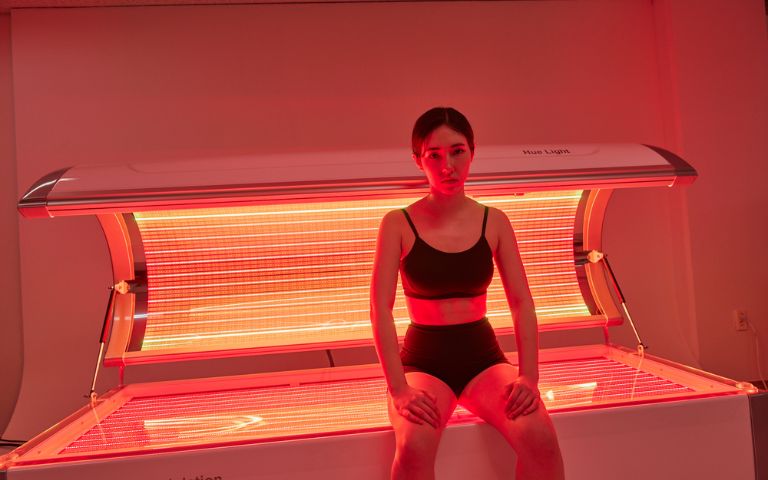
Breakdown of the Term:
- Photo = light
- Bio = life
- Modulation = altering or influencing
Photobiomodulation (PBM) is a therapeutic technique that uses specific wavelengths of light for low-level light therapy, typically between 600 and 1000 nanometers (nm), to stimulate cellular function and mitochondrial activity. The light interacts with mitochondria, the powerhouse of cells, enhancing adenosine triphosphate (ATP) production, which fuels cellular repair, tissue regeneration, and cellular metabolism.
Unlike high-intensity lasers used in surgical procedures, PBM employs low-intensity light, making it a non-invasive treatment that avoids heat and tissue damage, ensuring patient comfort and safety.
PBM is widely studied in clinical settings for its potential to treat conditions such as:
- Pain relief: Osteoarthritis, fibromyalgia, and musculoskeletal pain
- Wound healing: Diabetic ulcers, surgical recovery
- Neurology: TBI, stroke recovery, cognitive decline (Alzheimer’s)
- Regeneration: Nerve damage, tissue inflammation
Devices used for PBM include lasers, light-emitting diodes (LEDs), and other advanced light-emitting technologies. These are often found in medical facilities, though some portable devices are available for home use under professional guidance. PBM devices are often regulated, FDA-cleared, and used under medical supervision in physiotherapy, dental, and neurology clinics.
Supporting research: A 2019 meta-analysis published in BMJ Open found that PBM significantly reduced pain and improved function in patients with knee osteoarthritis, highlighting its clinical efficacy.
What is Red Light Therapy (RLT)?
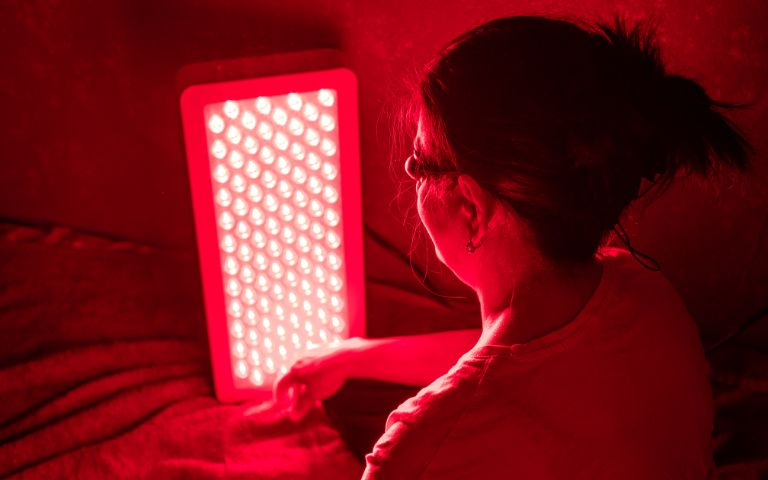
Red light therapy (RLT) is often considered a subset of PBM, focusing specifically on red (620–700 nm) and near-infrared (700–850 nm) light. Like PBM, RLT promotes healing by stimulating cellular processes, particularly by reducing inflammation and enhancing tissue repair. However, RLT is typically marketed for consumer use, making it more accessible for at-home treatments.
RLT is popular for:
- Skin health: Reduces fine lines, acne, and inflammation
- Hair regrowth: FDA-cleared helmets for androgenic alopecia
- Muscle recovery: Accelerates healing post-exercise
- Mood and energy: Some biohackers use it to fight seasonal affective disorder (SAD), partly due to its potential role in improving blood circulation, which may influence mental clarity and energy levels.
RLT devices, such as LED panels, handheld units, and wearable masks, are widely available over the counter. These devices are user-friendly, requiring minimal technical expertise, which has fueled their popularity in the wellness industry.
Supporting data: A 2014 study in Photomedicine and Laser Surgery demonstrated that RLT improved skin complexion and collagen density in participants, supporting its use in aesthetic treatments.
Red Light Therapy is a more consumer-friendly term often used in wellness, beauty, and biohacking spaces. While technically a form of PBM, it’s usually associated with at-home or aesthetic uses. Unlike PBM, RLT products are often unregulated, which means efficacy varies by brand, light intensity, and user consistency.
Key Similarities Between PBM and RLT
While PBM and RLT differ in scope, they share several core similarities:
- Mechanism: Both use low-intensity light to stimulate cellular activity, primarily by enhancing mitochondrial function.
- Non-Invasive: Neither therapy involves surgery or significant discomfort, making them safe when used correctly.
- Applications: Both are effective for pain relief, pain management, inflammation reduction, tissue repair, wound healing, and collagen production.
- Scientific Backing: Both are supported by a growing body of research, with studies validating their efficacy for various conditions.
For instance, both therapies have been shown to reduce inflammation in conditions like tendinitis, with clinical trials reporting up to a 30% reduction in pain scores after consistent use.
Key Differences Between PBM and RLT
Understanding the distinctions between PBM and RLT is crucial for selecting the right therapy. Here are the primary differences:
1. Scope of Wavelengths:
-
- PBM encompasses a broader range of wavelengths (600–1000 nm), including red and near-infrared light, allowing for diverse applications.
- RLT focuses on a narrower range (620–850 nm), primarily targeting superficial tissues like skin, muscle, and tissue repair.
2. Application Settings:
-
- PBM is often used in clinical or research settings, where precise protocols and professional oversight ensure optimal results.
- RLT is more consumer-oriented, with devices designed for home use, making it accessible but potentially less precise.
3. Device Complexity:
-
- PBM may involve advanced laser systems or medical-grade LED devices, often requiring trained professionals to operate.
- RLT typically uses simpler LED-based devices, such as panels or masks, designed for ease of use.
Regulatory Considerations:
-
- PBM devices, especially those used in medical settings, may require FDA clearance or other certifications due to their clinical applications.
- RLT devices are often sold as wellness products, with fewer regulatory requirements, leading to variability in quality.
How Do These Therapies Work at the Cellular Level?
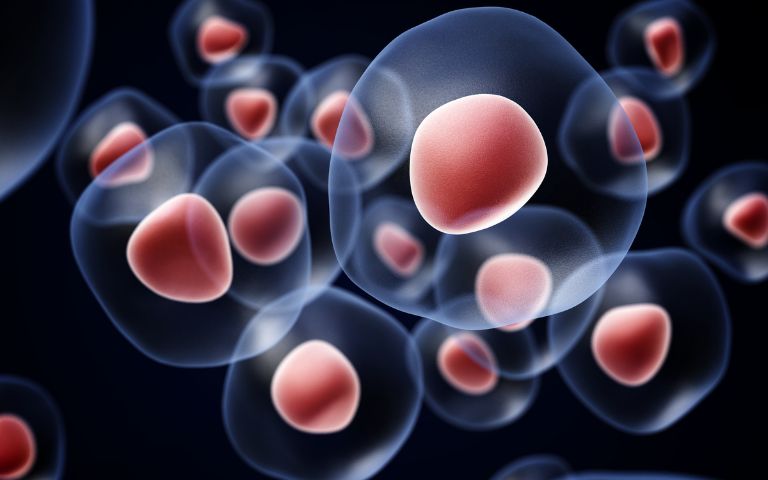
Both PBM and RLT use photons (light energy) to influence cellular processes, particularly in the mitochondria. Here’s what happens:
Mechanism:
- Light penetrates skin and tissue.
- Mitochondrial enzymes (especially cytochrome c oxidase) absorb light.
- ATP (energy) production increases, supporting cellular repair and tissue regeneration.
- Oxidative stress decreases, improving cellular function.
- Nitric oxide is released, enhancing blood flow and reducing inflammation.
In PBM:
The focus is on delivering light at the right dose and depth to impact healing, for example, targeting brain tissue in TBI patients using 810 nm pulsed light.
In RLT:
The goal may be more superficial, such as collagen stimulation in the skin or muscle relaxation after a workout.
Clinical vs. At-Home Use
PBM – Clinical Use
- Administered by professionals
- Often part of a larger therapy protocol
- Devices like Thor Laser, LiteCure, and Weber Medical are used
- Used in neurology, oncology support, and post-surgical care
RLT – At-Home Use
- Handheld or panel devices like Joovv, Mito Red, and PlatinumLED
- Generally safe for unsupervised use
- Good for daily maintenance, skin support, and light recovery
Caution: Not all RLT devices are created equal—some have insufficient power or use ineffective wavelengths.
Safety Concerns
Both therapies are generally safe but require precautions:
- Eye Protection: Prolonged exposure to bright light can harm the eyes, so protective goggles are recommended.
- Proper Dosage: Overuse or incorrect settings can reduce efficacy or cause skin irritation.
- Contraindications: Individuals with photosensitivity or certain medical conditions (e.g., epilepsy) should consult a healthcare provider before use.
PBM vs. Red Light Therapy: Which is Right for You?
Selecting the right therapy depends on your goals, budget, and access to professional care:
Choose PBM if:
- You have a chronic medical condition (e.g., arthritis, neuropathy) requiring precise treatment.
- You have access to clinical facilities or professional-grade PBM devices.
- You’re seeking advanced applications, such as neurological or deep-tissue therapies.
Choose RLT if:
- Your goals are general wellness, skin rejuvenation, anti-ageing, or muscle recovery.
- You prefer at-home treatments with user-friendly devices.
- Budget is a concern, as RLT devices are more affordable and widely available.
Choosing a Device: Why the Hue Light Whole-Body PBM Chamber Stands Out
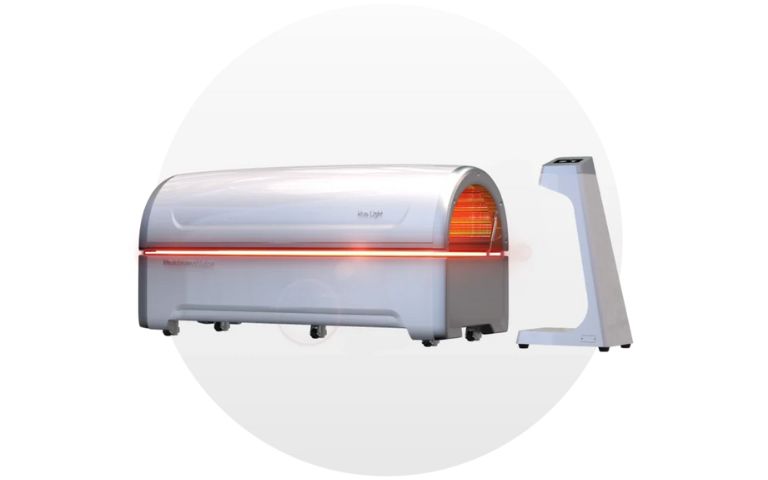
If you’re considering red light therapy or photobiomodulation for long-term wellness, the type of device you use can dramatically influence your results. While handheld RLT devices and small LED panels are effective for targeted use, they often fall short when it comes to full-body benefits or deeper tissue penetration.
That’s where the Hue Light Whole-Body PBM Treatment Device sets itself apart.
This advanced system is designed to deliver professional-grade therapy in a convenient, full-body chamber—ideal for clinics, wellness centers, and individuals who want comprehensive, science-backed light therapy at home. Unlike consumer-level red light panels, the Hue Light chamber uses:
- Over 40,000 LEDs to ensure even light distribution across the entire body
- Multi-wavelength support, including red, near-infrared (NIR), and green light
- Precise frequency programming (including Nogier frequencies) to target specific therapeutic outcomes
- App-based controls for easy customization of treatment sessions
Whether your goal is pain relief, cognitive support, tissue recovery, or whole-body rejuvenation, the Hue Light system is built to deliver consistent, clinical-level results safely and efficiently.
Explore the full details here: Hue Light PBM Treatment Device
